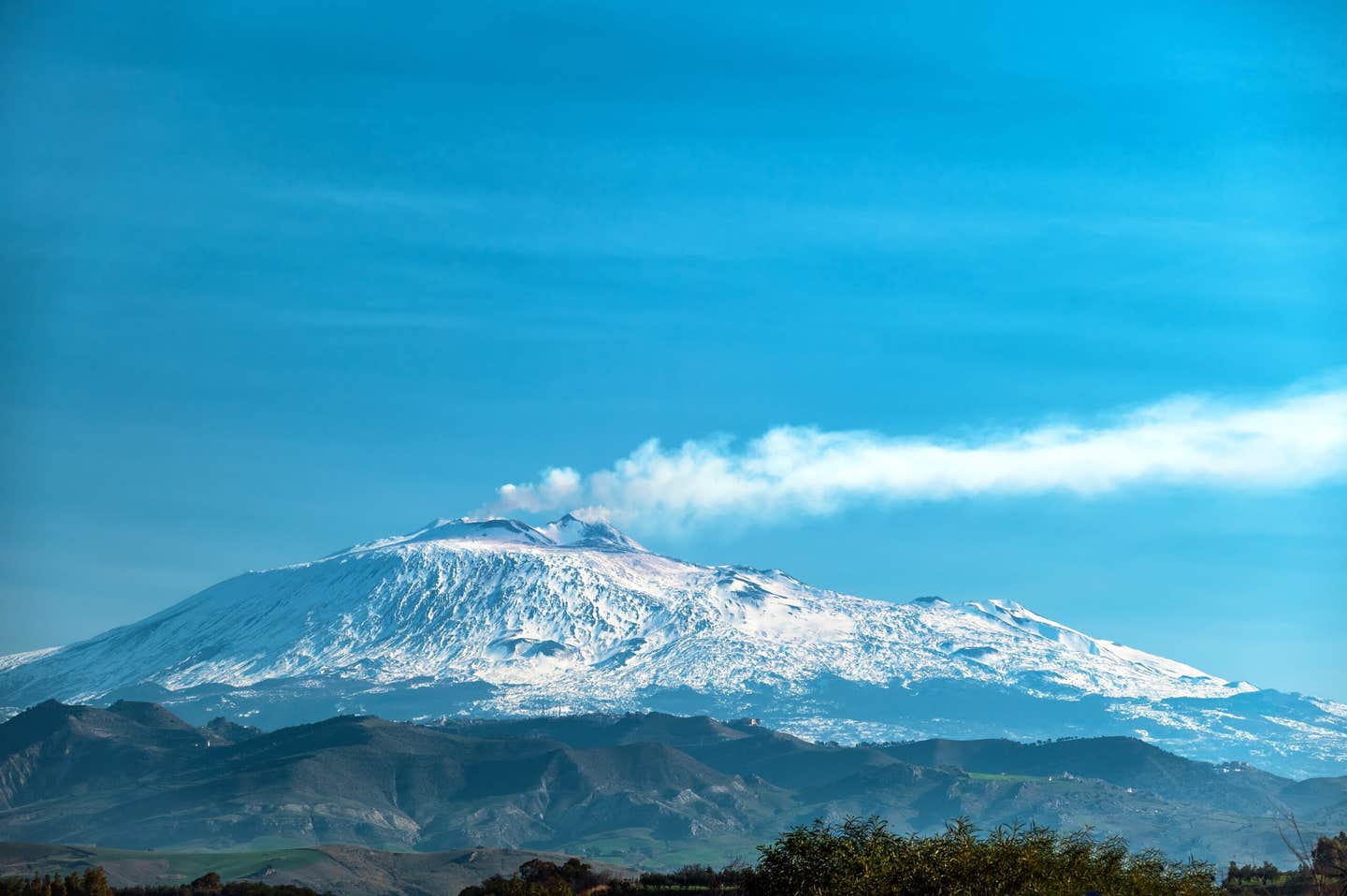20-year study reveals new way to predict Mount Etna’s next eruptions
Researchers studying Mount Etna’s two decades of seismic data have uncovered a reliable way to forecast eruptions—by tracking the ratio of small to large earthquakes.

Researchers studying Mount Etna’s two decades of seismic data have uncovered a reliable way to forecast eruptions. (CREDIT: Shutterstock)
High over the island of Sicily, Mount Etna smolders as Europe's most active volcano. Underneath its rough slopes, a network of magma chambers and fractures seethes in virtual quiet—until the earth starts to shake. For twenty years, scientists have been paying close attention to those rumblings, learning rhythms that someday might make volcanic predictions more precise than ever.
Following the Pulse of an Active Giant
A team led by geophysicist Marco Firetto Carlino at Italy's National Institute of Geophysics and Volcanology (INGV) analyzed 20 years' worth of seismic data from Etna, between 2005 and 2024. They sought to interpret what the volcano's tens of thousands of small and big earthquakes reveal about the motion of magma inside the volcano.
Built into everything they do is a number called the b value—a measure of how large the number of little quakes is relative to the number of large ones. When magma intrudes by pushing up, it breaks up the rock surrounding it, and small tremors are created in sets. These small quakes increase the b value. When stress is building and pressure accumulates, the small quakes occur less frequently and larger ones dominate, decreasing the b value.
"Those movements in the b value describe the manner that stress in the volcano varies," explained Firetto Carlino. "Since increasing magma that rises alters that stress, tracking the b value can assist in revealing multiple stages of magma transport from deep to surface."
Two Decades of Data Beneath the Surface
To map out these shifts, the researchers divided the crust beneath Etna into slices—less than 3 kilometers thick to more than 17 kilometers beneath the surface—and identified 11 primary volumes in which earthquake energy was accumulated. By comparing the patterns of quakes to ground deformation picked up by GPS stations on the slopes of Etna, they found one area that stood out: an area 3 to 7 kilometers deep on the volcano's east flank.
This middle-crustal level, labeled "V6" in the study, displayed a direct correspondence between inflation of the volcano's surface and seismic strain. That is to say, whenever the volcano inflated, which meant magma was ascending, tiny earthquakes skyrocketed within that very same depth zone.
This connection suggests that the 3–7 km level is a critical staging zone, where magma piles up and pressures build before continuing to the surface. Higher levels have small earthquakes ride shotgun with dike intrusion and near-surface fracturing when eruptions occur. Below, deeper areas seem to feed magma up but are less immediately connected with surface deformation.
Mapping Magma's Journey
Mount Etna's crust is similarly thick, about 30 kilometers (19 miles) deep, and cut by a complex strike-slip fault where the African and European tectonic plates meet. Magma starts at a deep reservoir about 11 kilometers below sea level, rises to intermediate storage systems from 3 to 7 kilometers deep, then feeds shallow chambers close to the summit.
The INGV team concludes that the b value is a surprisingly good indication of where and how magma moves along this route. Areas with hot fluids and fractures have high b values, meaning many small earthquakes. Areas with high stress and fewer fractures have lower values, meaning fewer but larger earthquakes.
By following what this ratio does over time, scientists can essentially plot magma's ascension in real-time. A surge in small quakes at a certain depth can be an indicator of magma forcing its way up, and a sudden drop can be a sign of pressure building for a larger event.
A New Type of Early Warning
This process worked especially well when the group used it on the recent history of Etna. Before the volcano's eruption in June 2025, which sent a 6.5-kilometer (4-mile) ash plume into the atmosphere, early warning signs manifested in the b value months before any gas emission or surface deformation.
That timing may be critical for future monitoring. "Our findings indicate that b value monitoring may have predicted volcanic crises," the authors stated. Being able to pick up on such signals beforehand may provide local officials with additional time to alert citizens and organize evacuations.
Because there are so many quakes that can be detected annually by Etna, it's an ideal testing ground. But the method can also be applied to other active volcanoes—anywhere there is a good seismic network and well-mapped crustal structure.
Challenges Beneath the Data
However, scientists say that there is no single volcano that is identical to another. Precise attention and good data are required in the interpretation of changes in b values. Several factors, ranging from local tectonic stress to landslides and fault displacement, impact earthquake statistics.
To make this tool effective globally, scientists need dense arrays of seismometers, accurate location of quakes, and constant monitoring of other indications of volcanic activity like gas emission and heat movement. Even supposing those are available, it remains a human challenge as much as a scientific one to translate all that information into clear, actionable warnings for the public.
Practical Implications of the Research
This study gives volcanologists a more precise tool to read magma's behavior and make better eruption forecasts. Being able to track the b value allows researchers to identify where the magma is accumulating and if it will keep rising. That can improve safety for populations near active volcanoes—not just in Sicily but everywhere.
On the ground, raising b values could be a sign of active but secure magma flow, while reducing values could signal experts to an unstable pressure buildup. With surface deformation information added, the technique could issue warnings sooner than current systems that track gas and surface-visible activity alone.
For people living on Etna's slopes—and for the millions across the world who have volcanoes looming over them—this research holds the promise to tame eruptions of nature.
Research findings are available online in the journal Science Advances.
Related Stories
- Mount Vesuvius's 79 A.D. eruption was far more devastating than imagined
- Massive underwater volcano off the coast of Oregon is getting ready to erupt
- Geologists solve one of Earth's oldest volcanic “super-eruption” mysteries
Like these kind of feel good stories? Get The Brighter Side of News' newsletter.
Joshua Shavit
Science & Technology Writer and Editor
Joshua Shavit is a Los Angeles-based science and technology writer with a passion for exploring the breakthroughs shaping the future. As a co-founder of The Brighter Side of News, he focuses on positive and transformative advancements in AI, technology, physics, engineering, robotics and space science. Joshua is currently working towards a Bachelor of Science in Business and Industrial Engineering at the University of California, Berkeley. He combines his academic background with a talent for storytelling, making complex scientific discoveries engaging and accessible. His work highlights the innovators behind the ideas, bringing readers closer to the people driving progress.



